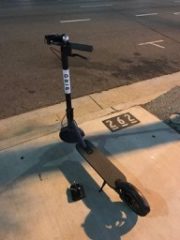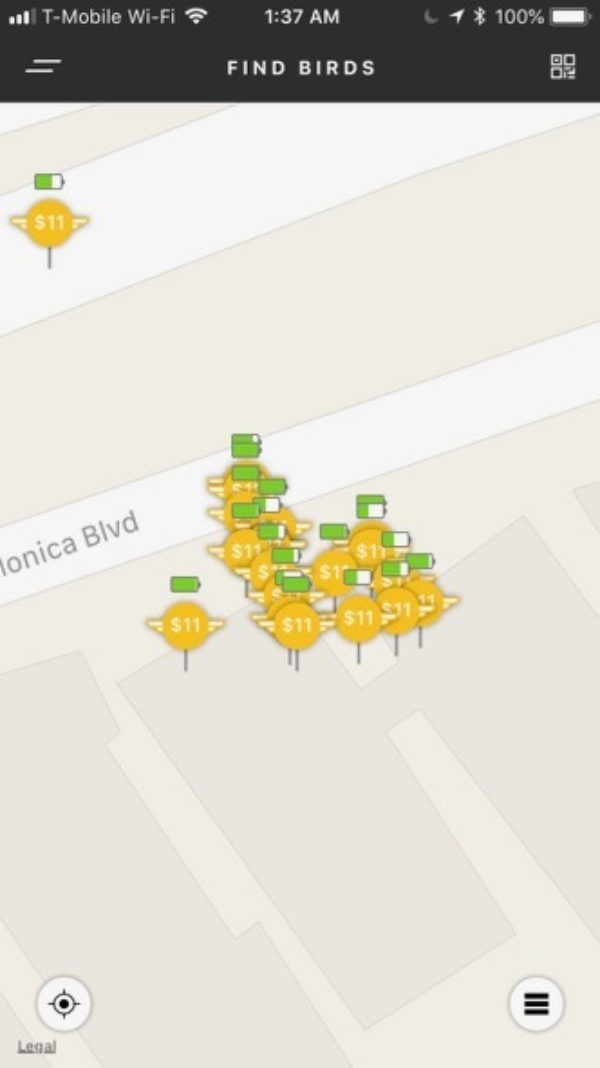The Thrill of the Bird Hunt
Bloomberg Opinion , August 07, 2018
I first heard about Bird hunting when a friend who knows of my Pokemon Go addiction sent me a link to this Atlantic article about how young people were picking up Bird scooters and charging them overnight. “Charging scooters for Bird is like Pokemon Go,” a San Franciscan who hunts with his girlfriend told reporter Taylor Lorenz, “but when you get paid for finding Pokemon.” The reported money wasn’t bad, either, “up to several hundred dollars a night.”
Curious and, I’ll admit, attracted by the promise of flexible earnings that didn’t require crafting sentences, I registered to be a Bird charger. I didn’t hear anything from the company and let it drop. But my Bloomberg Opinion conversation with Nat Bullard about the dockless scooter-sharing business piqued my curiosity again. The contractors who pick up the battery-powered scooters, charge them overnight and put them out in the early morning are essential to the success of the rental companies. What’s the job like? I nudged Bird, got my first charger packs and set to work.
As a 58-year-old with questionable coordination and a Honda Civic, I’m neither the ideal nor the typical Bird hunter. But I did glean some insights from actually doing the job.
1. False positives are a huge problem. To find scooters that need charging, Bird hunters get a map that shows their locations. They select a scooter, go to its location and “capture” it with the app, which releases its wheels, allowing the charger to easily transport it home, and takes it off the map. At least that’s the way it’s supposed to work. Unfortunately, a high percentage of these scooters aren’t actually where they’re supposed to be.
One night I walked up to a couple of young guys — UCLA students? — standing next to a scooter I’d seen on my map. “Are you done with this?” I asked, assuming they were riders. In fact, they were chargers out on their first Bird hunt, and, tipped off by someone at the nearby burger joint, this was the first real scooter they’d encountered. The others they’d tracked were ghosts. My first night I, too, located only one — just enough to convince me the app sometimes worked. It’s a common experience. “The reporting is in fact so bad that it took me 3 tries before I found my first bird, and that unit was being picked up by someone else,” blogged charger Jimi Smoot.
The more recently a scooter has been registered in a spot, the more likely it’s still there, but there are no guarantees. And you can forget finding any of the rare Birds promising $20 for pickup. They’re long gone.

2. Sunrise is an interesting time of day. Chargers have to return their scooters to designated spaces by 7 a.m. On my first outing, I left at 6:30. Big mistake. The nearest open Bird Nest required a three-mile drive and had only one slot available. Fortunately, thanks to my frustrating search the previous night, I had only one scooter to get rid of.
After that, I started going out shortly after 5 a.m., which put me in the company of other early risers who make things work, many of them in the building trades. I learned that a long line of construction trucks parks every morning along Santa Monica Boulevard, waiting to move to a building site on a residential street a half dozen blocks away. My favorite encounter was the morning I noticed an older Latino man cruising for discarded mattresses, which he stacked in the back of his truck. “What do you do with the mattresses?” I asked. He replaces the covers and resells them, he explained in heavily accented English. Whether in Los Angeles or south of the border I didn’t find out.
3. “You’ve got to hustle.” One of my first mornings, I got this advice from a blond guy with a surfer vibe who asked if the scooters I was setting out needed repairs. He was a Bird mechanic, a contractor who picks up and fixes broken scooters, and was eager to counsel a newbie. My small car should be no problem, he said, explaining how he could get six scooters in a Prius by sticking their handles out the window. To find more scooters, he suggested that I try Rodeo Drive. Too far, I said. (Beverly Hills has since bannedthe scooters.)
He was right about hustle. In 13 days of Bird hunting, from June 30 to July 25, I charged 32 scooters and earned $168.73. But, quickly giving up on driving, I stuck to walking distance and used only the first three charger packs I received from Bird. Even so, the work took a couple of hours a day. If you want to earn any significant money, you’ve got to try harder than I did. And, ingenious Prius packing notwithstanding, you really should have a large vehicle.

4. Chargers cheat, and I can’t entirely blame them. Aside from scooters that have vanished from their last known location, the Bird hunter’s bane is the guy who takes the hustling imperative too far. On my first several ventures out, I was tantalized by indications of nearby scooters that were too recently located to be ghosts but were nowhere in sight. I eventually realized that it wasn’t a glitch that the map showed them inside apartment buildings.
Night after night, it seems, a couple of neighborhood Bird hunters collect scooters off the street without “capturing” them — either by renting them for just long enough to get them inside or by carrying them with locked wheels. The Birds’ icons still show up on the map, driving hunters like me crazy. The hoarders plug the scooters in immediately but hold them for official capture until the wee hours. After about 11, the charging value increases to at least $7 from $5. Around 4 a.m., when chargers can start releasing scooters, they officially capture their finds and get paid on release.
The cheating made me mad. Then one morning, shortly after 4, I saw one of the likely offenders leaving his apartment building and loading Birds into his trunk. Like the surfer-ish mechanic, he was an L.A. type, a young black man with the biceps of a personal trainer, aspiring action star or both. As I returned from walking a couple of Birds to their new Nest, he was riding a scooter with another one loaded across it. “Why do you walk?” he asked. “I always see you walking” the scooters. I said something about my lack of coordination and added that I’d once seen someone riding a scooter and carrying three other ones. That’s a bit much, he said. Sweat was beading across his forehead and upper lip. Working hard, I thought, or maybe it was the lack of air conditioning in his building. Either way, he was young and paying exorbitant Westside rent. No wonder he was trying to snag an extra few bucks a night.
5. Gamification works. Even as a side hustle, Bird hunting doesn’t pay well. Higher payments, however, would make the business unsustainable. The genius of the system lies in the comparison that prompted my friend to send me that Atlantic article in the first place: Bird hunting is like a game. (It’s also a good complement to Pokemon Go.) Even the otherwise annoying false positives just make it more challenging; a savvy hunter knows where not to waste time. “You like this,” remarked my husband, who personally found one night of tracking Birds enough for a lifetime. Aside from getting up around 4 a.m. and occasionally giving myself incredibly painful bruises, I do. It’s fun tracking Birds. My journalistic research is done, but once I recover from my latest self-inflicted wounds, I plan to get back to it.
To provide a comparison, I later registered as a “Juicer” for competitor Lime, but I found that there were too few scooters left near my house to make collecting practical.